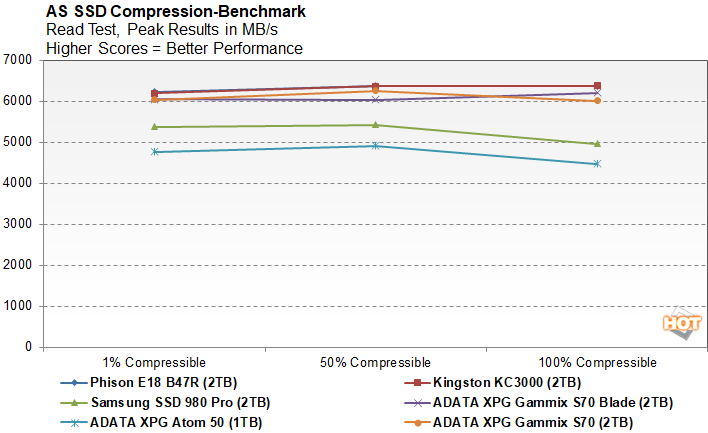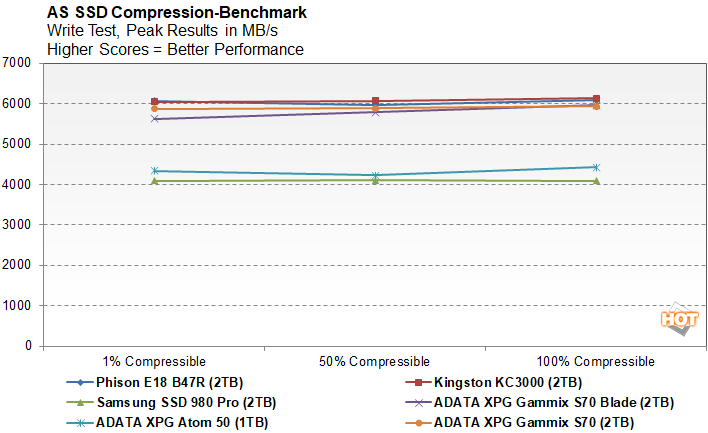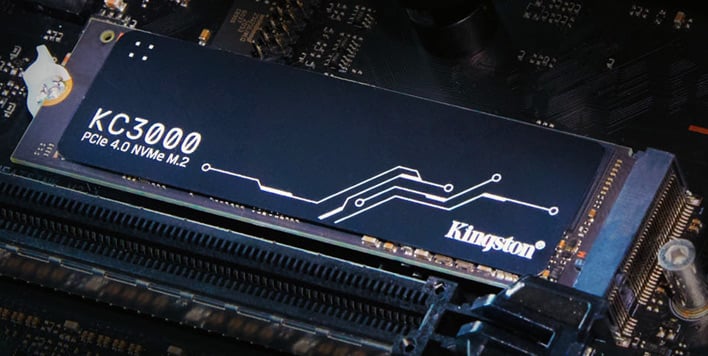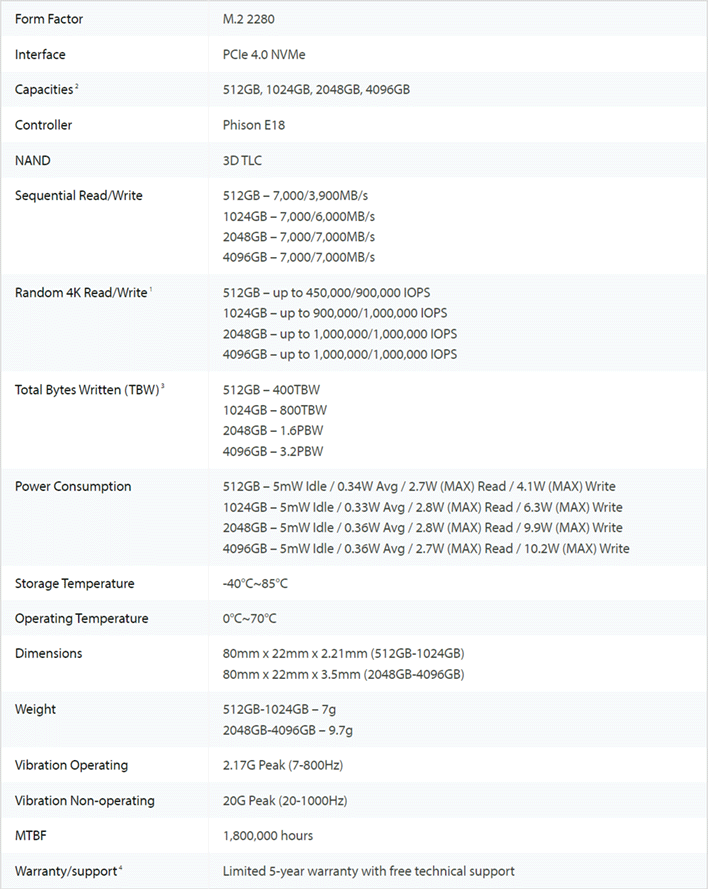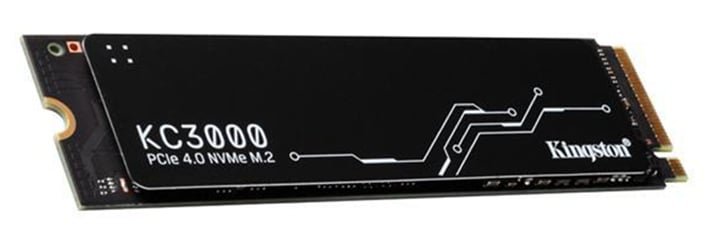Kingston KC3000 SSD Review: A PCIe Gen 4 Speed Demon
Kingston KC3000 Review: High Performance, Low Latency NVMe Storage
The Kingston KC3000 is the latest update to the company’s enthusiast-class M.2 SSD line-up. These PCIe 4 x 4 drives feature some of the latest components available and are tuned for high-performance across an array of applications and use cases. KC3000 drives are also available in relatively high capacities, topping out at a healthy 4TB. Take a look at their main features and specifications below and then we’ll dive into some benchmarks to see how the Kingston KC3000 currently stacks up versus some other PCIe Gen 4-based competition...
Kingston KC3000 Specifications And Features
Similar to the overwhelming majority of NVMe M.2 drives currently on the market, the Kingston KC3000 uses the common M.2 2280 (80mm) "gumstick" form factor. Kingston utilizes an attractive, dark-colored PCB with the KC3000, and populates both sides of the board with an array of components (at least on the 2TB model we evaluated). Both sides of the PCB are covered, however, either by a stylized graphene/aluminum heatspreader (top) or by large decal (bottom) adorned with all of the drive’s pertinent data and branding.
The foundation of the Kingston KC3000 is an 8-channel Phison E18 controller, which is common among today’s top PCIe 4 SSDs. That controller is paired to some Kingston-assembled and branded Micron 176-Layer 3D TLC NAND Flash memory operating at 1600MT/s, a few pieces of DDR4-1600 DRAM cache, and a customized Kingston firmware. Other features of the drive include a PCIe Gen x4 interface and support for the NVMe 1.4 specification. Unlike the older KC2000, however, the KC3000 doesn’t support TCG Opal or some other encryption and security technologies.
The ultimate performance of the Kingston KC3000 will vary somewhat depending on the capacity of the drive being tested. We are looking at a 2TB drive here. Kingston rates the drives for up to 7,000 / 7,000MB per second reads and writes, respectively, with up to 1M read and write IOPS. The lower capacity 1TB drive, however, peaks at 6,900MB/s writes and the 512GB drive 3,900MB/s. Endurance for the 2TB drive we have here is rated for 1.6PBW, though that number also shoots upward or downward depending on the total capacity. Kingston also backs the drives with a full, five year warranty.
The specs for the KC3000 look all look great, but that doesn’t mean much if its measured performance isn’t good, so let’s get to some testing...
Kingston KC3000 PCIe 4 SSD Benchmarks
Under each test condition, the SSDs showcased here were installed as secondary volumes in our testbed, with a separate drive used for the OS and benchmark installations. Our testbed's motherboard was updated with the latest BIOS available at the time of publication and Windows 11 was fully updated. Windows firewall, automatic updates, and screen savers were all disabled before testing and Focus Assist was enabled to prevent any interruptions.
In all test runs, we rebooted the system, ensured all temp and prefetch data was purged, and waited several minutes for drive activity to settle and for the system to reach an idle state before invoking a test. All of the drives here have also been updated to their latest firmware as of press time. Where applicable, we would also typically use any proprietary NVMe drivers available from a given manufacturer, but all of the drives featured here used the Microsoft driver included with Windows 11.HotHardware's Test System:
| Processor: AMD Ryzen 9 5950X Motherboard: Gigabyte Aorus X570 Pro Wi-Fi (X570 Chipset) Video Card: GeForce RTX 3080 Memory: 32GB G.SKILL DDR4-3200 Storage: Samsung SSD 980 Pro (OS Drive) ADATA XPG GAMMIX S70 Blade (2TB) ADATA XPG Atom 50 (1TB) Samsung SSD 980 Pro (2TB) ADATA XPG GAMMIX S70 (2TB) Phison E18 w/ B47R (2TB) Kingston KC3000 (2TB) |
OS: Windows 11 Pro x64 Chipset Drivers: AMD v3.10.22.706 Benchmarks: IOMeter 1.1 HD Tune v5.75 ATTO v4.01.02f AS SSD SiSoftware SANDRA CrystalDiskMark v8.0.4 x64 Final Fantasy XiV: Endwalker PCMark 10 Quick Storage Bench |
IOMeter Benchmarks
IOMeter is a well-respected industry standard benchmark. However, despite our results with IOMeter scaling as expected, it is debatable as to whether or not certain access patterns actually provide a valid example of real-world performance. The access patterns we tested may not reflect your particular workloads, for example. That said, we do think IOMeter is a reliable gauge for relative throughput, latency, and bandwidth with a given storage solution. In addition, there are certain highly-strenuous workloads you can place on a drive with IOMeter, that you can't with most other storage benchmark tools.In the following tables, we're showing two sets of access patterns; a custom Workstation pattern, with an 8K transfer size, consisting of 80% reads (20% writes) and 80% random (20% sequential) access and a 4K access pattern with a 4K transfer size, comprised of 67% reads (33% writes) and 100% random access. Queue depths from 1 to 16 were tested...
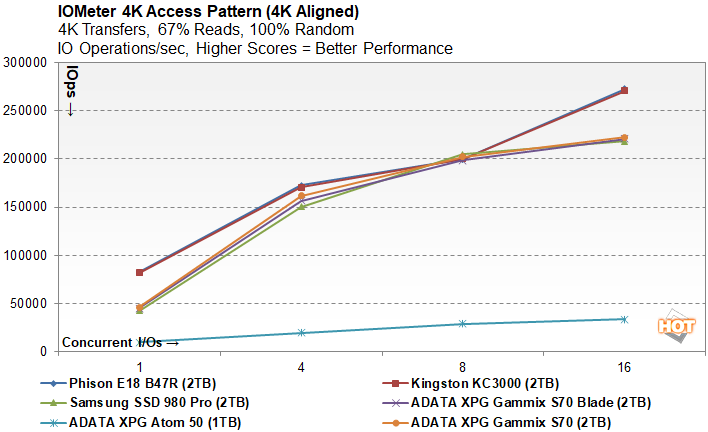
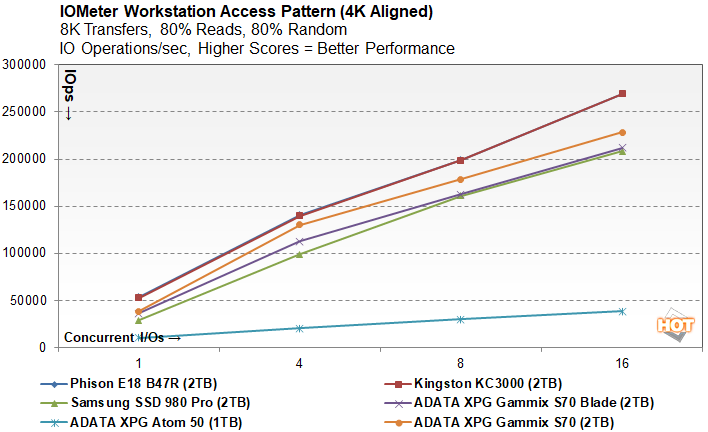
The Kingston KC3000 offered class-leading performance across both access patterns and at every queue depth we tested. The Phison E18 B47R reference drive was right there alongside it, but that's not a drive you can buy -- it was a test vehicle provided by Phison.


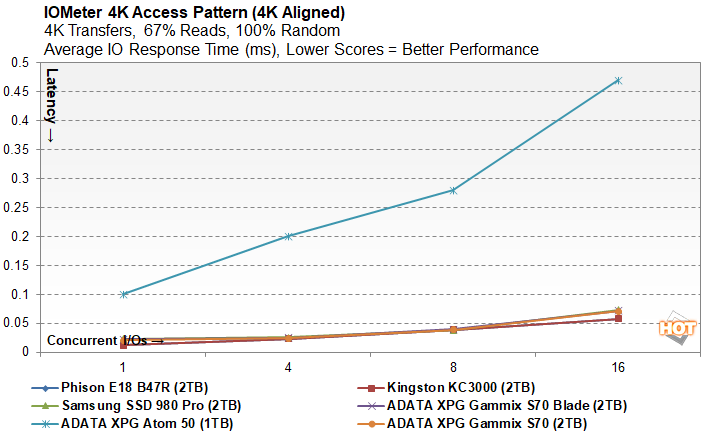
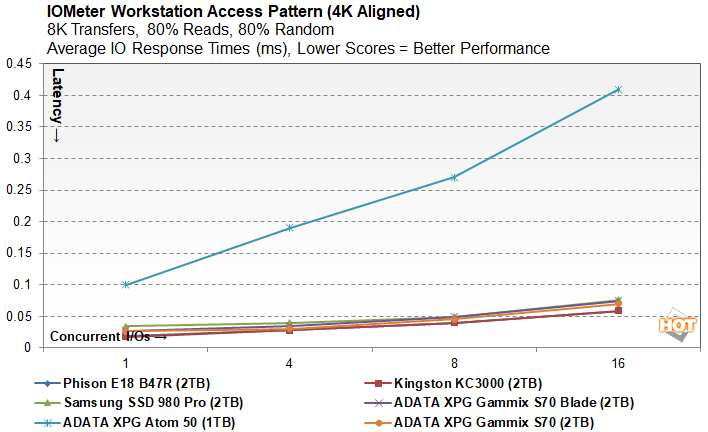
Our latency results also show the Kingston KC3000 offering some of the best latency characteristics across the board. With both access patterns and at every queue depth, the KC3000 performed exceptionally well.
SiSoft SANDRA 2021
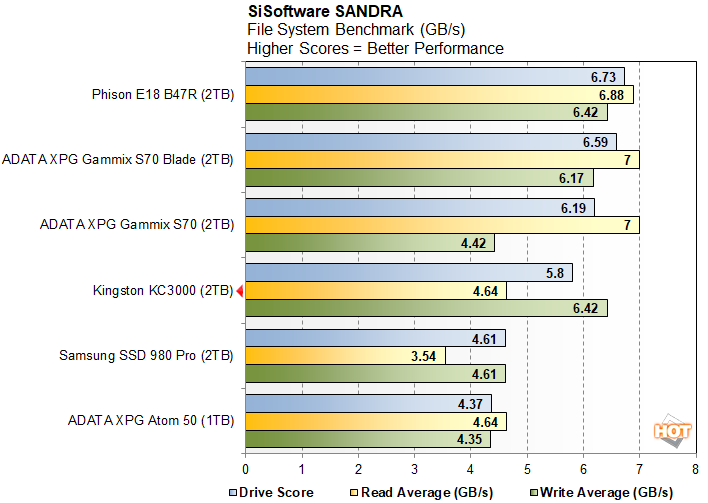
The SANDRA file system benchmark didn't seem to play well with the Kingston KC3000. We were expecting performance similar to the Phison E18 reference drive, but the Kingston drive's read result consistently trailed the Phison E18 and Innogrit-based drives. It had no trouble outrunning the Samsung drive, though.
ATTO Disk Benchmark
ATTO is another "quick and dirty" type of disk benchmark that measures transfer speeds across a specific volume length. It measures raw transfer rates for both reads and writes and graphs them out in an easily interpreted chart. We chose .5KB through 64MB transfer sizes and a queue depth of 6 over a total max volume length of 256MB. ATTO's workloads are sequential in nature and measure raw bandwidth, rather than I/O response time, access latency, etc.
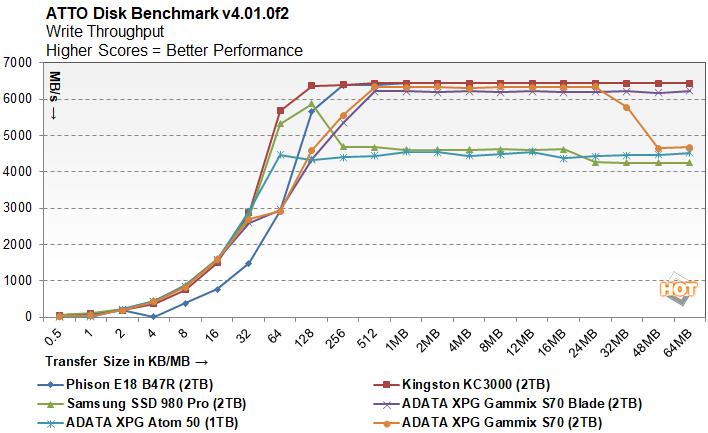
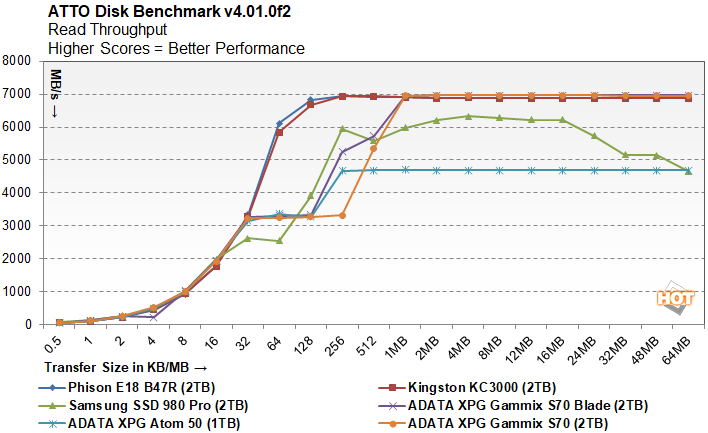
The Kingston KC3000 didn't quite hit its rated write speed of 7GB/s in ATTO, but it did clear that mark in the read tests and offered leading performance across the board.
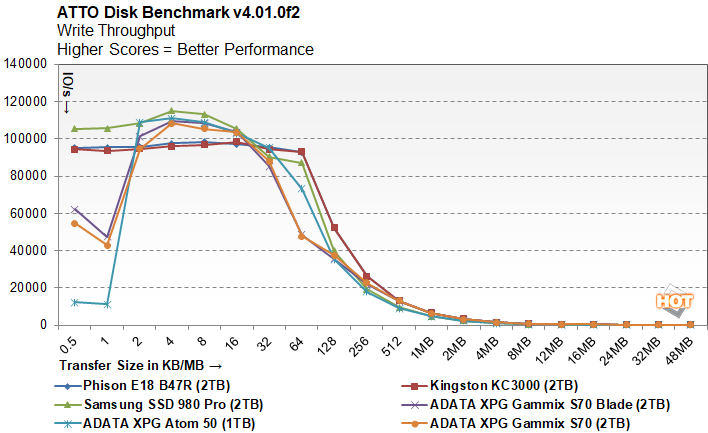
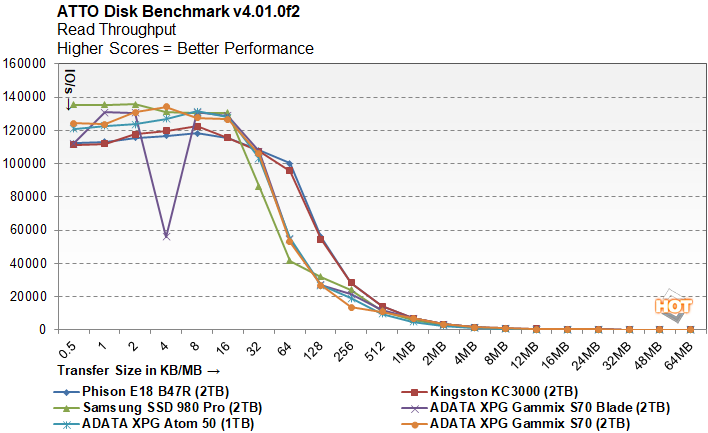
IO performance according to ATTO had the KC3000 offering strong, consistent performance all the way up to the 256MB transfer size in the write test. In the read test, the KC3000 once again offered relatively consistent performance with the smallest transfer sizes, but it trailed until it crossed the 64MB mark, at which point it pulled ahead of the competition yet again.
AS SSD Compression Benchmark
Next up we ran the Compression Benchmark built-into AS SSD, an SSD specific benchmark being developed by Alex Intelligent Software. This test is interesting because it uses a mix of compressible and non-compressible data and outputs both Read and Write throughput of the drive. We only graphed a small fraction of the data (1% compressible, 50% compressible, and 100% compressible), but the trend is representative of the benchmark’s complete results.
